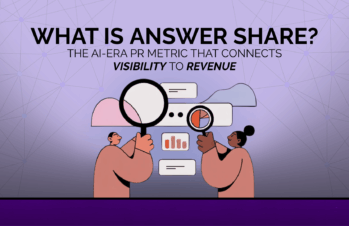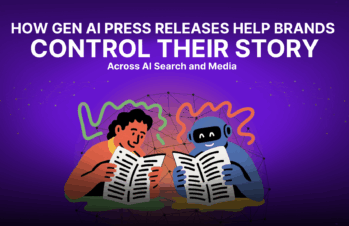Google has once again demonstrated its commitment to enhancing user trust. With its latest foray into search innovation—the “Mentioned in” feature—Google is not just refining the search experience but is also underscoring the irrefutable power of earned media. If you’re still doubting the value of earned media, this is a wake-up call.
The “Mentioned In” feature, seamlessly incorporated into search results, allows users to see snippets of what other websites the search result website is mentioned in.
Talk about third-party credibility.
The feature is presently being tested as a drop-down menu for users to prompt and as an automatic feature. To those acquainted with Google’s offerings, this might remind you of the “About this result” tool, providing context to search outcomes. However, “Mentioned In” goes a step further by offering a trail of third-party references.
Ignoring earned media is not an option for businesses striving for digital prominence. Google’s new feature not only amplifies the influence of mentions but also serves as a barometer for trustworthiness. Websites recognized by other notable sources are now getting their well-deserved nod in search results.
In essence, the digital landscape is echoing a long-known truth: third-party endorsements, in the form of earned media, carry significant weight. And with Google’s evolving algorithms prioritizing these mentions, it’s clear that the future of SEO will be tied to the power of earned media.
What does Google’s “Mentioned In” feature mean for B2Bs?
Google’s innovations never occur in a vacuum. They shape strategies, influence behaviors, and define best practices. For B2Bs, this new feature means it’s time to reevaluate the brands’ digital presence—and invest in strategies that garner mentions from trusted sources.
Either way, here’s the truth: References, endorsements, and mentions impact search rankings.
The landscape has shifted and partnerships, collaborations, and third-party validations are more important than ever.
The Power of Validation and Trust in Search
Having quality articles pop up in your brand’s “Mentioned In” snippets bestows a badge of credibility—especially if you’re doing earned media right and the snippets are from sources your audience already knows and trusts. (And sometimes niche is better!) Users are no longer solely reliant on a site’s self-proclaimed expertise; they can now see the digital ‘footprints’ a site has made across the web.
Before “Mentioned In” consumers may have cross-checked facts and searched for reviews. While they will likely still continue those habits, Google streamlines the process for them and puts that information front and center.
Google is, in effect, helping the brands that help themselves by having a quality earned media presence that is visible and consistent.
How can brands take advantage of the latest Google search feature?
1. Create quality content consistently.
Action: Regularly publish high-quality, authoritative B2B content on your website.
Why: Besides attracting organic traffic, great content can also draw mentions from other reputable sources. The better your content, the more likely it will be referenced by others.
2. Engage in collaborations and partnerships.
Action: Partner with industry influencers, bloggers, and other businesses for guest posts, webinars, or co-authored whitepapers.
Why: Such collaborations can lead to reciprocal mentions, expanding your brand’s reach.
3. Monitor your brand.
Action: Use tools like Google Alerts, Mention, or Brandwatch to keep track of where and how your brand is mentioned.
Why: Monitoring allows you to see the context of mentions, gauge sentiment, and respond if needed.
4. Be engaging on social media.
Action: Regularly share your content, participate in industry discussions, and actively engage with followers on major social platforms.
Why: Active engagement can lead to more shares, discussions, and mentions on websites or blogs.
5. Build strong relationships.
Action: Cultivate relationships with media outlets, submit press releases, and offer your expertise for interviews or quotes.
Why: Positive media exposure can lead to numerous high-quality mentions.
6. Seek testimonials and reviews.
Action: Encourage satisfied clients or customers to leave testimonials or reviews. Share these on your website and social channels.
Why: Genuine testimonials can not only enhance trust but also inspire others to mention or reference your brand.
7. Optimize for SEO.
Action: Ensure that your website and content are optimized for search engines, incorporating relevant keywords and staying updated with B2B SEO best practices.
Why: A well-optimized site is more likely to increase rank, visibility, and mentions.
8. Create and join community forums.
Action: Participate in industry-specific forums, Q&A sites like Quora, and other community platforms. You can even build your own groups on Facebook or LinkedIn for industry-specific discussion and knowledge sharing.
Why: By providing valuable insights and answers, you position your brand as an authority, leading to more mentions and references.
9. Regularly audit and refine your strategy.
Action: Periodically review your strategies for earning mentions, evaluate the quality and source of these mentions, and refine your approach.
Why: Continuous refinement ensures that you stay aligned with changing trends and get the best return on your efforts.
Google’s “Mentioned In” signals a pivotal shift in search dynamics, emphasizing third-party validations and mentions as cornerstones of digital credibility. In an age where the digital footprints of a brand matter more than ever, Google’s innovation serves as both a reminder and an opportunity: The mentions you earn today will shape your digital narrative tomorrow.
Want to learn how to write the best digital narrative your brand can have? Reach out today.




